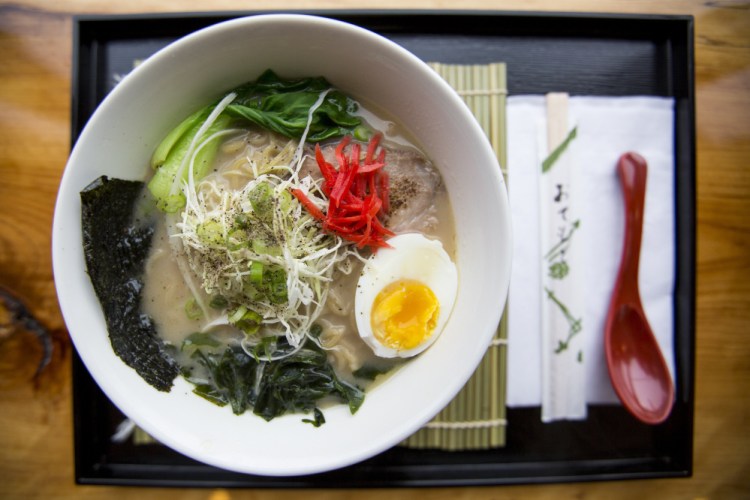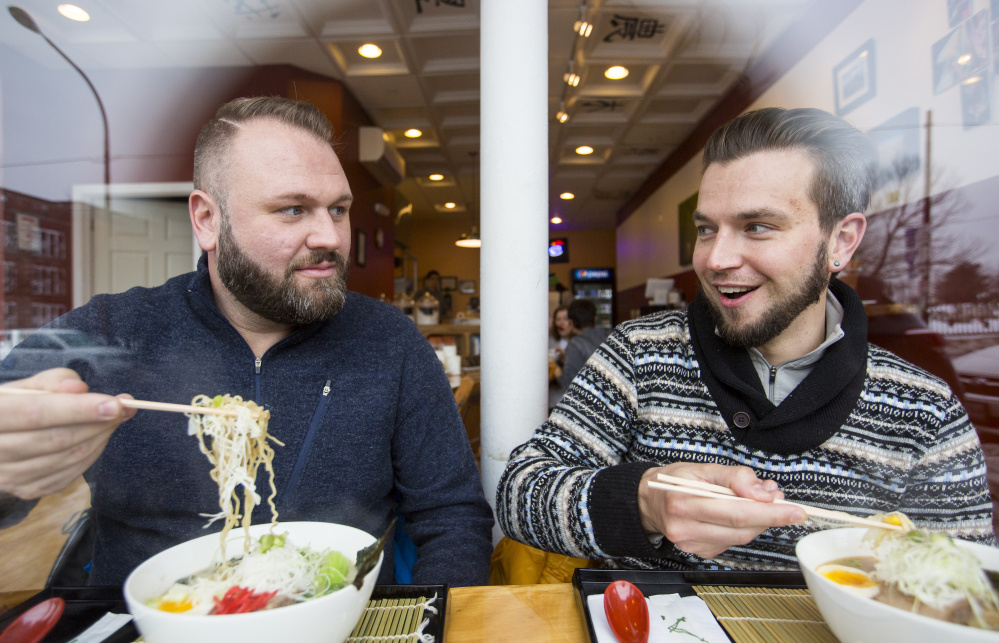Kei Suzuki has an eye for detail.
You notice it the moment you walk into Ramen Suzukiya, the tiny, brightly lighted noodle shop that he and his son, Cory, designed and opened on Congress Street early last summer.
It’s evident in the Japanese and Chinese characters that he painted onto the coffered ceiling; most refer to food and friendship, a few others spell out his last name. (“-Ya,” by the way, is the Japanese suffix used to denote a family business. Suzukiya basically means “Suzuki family firm.”)
It’s visible in the long community table that he commissioned for the center of the room – an enormous, live-edged slab of white pine held together with inlaid bowties and polished to a mirror sheen.
And it’s obvious the moment you see a ramen bowl delivered to that table atop a plain bamboo mat and filled to the brim with a mound of glistening house-made noodles, artfully sliced vegetables and one half of a delicately cooked soft-boiled egg, its golden yolk oozing out and enriching the aromatic broth.
Those ingredients and the entire menu may be simple (Suzukiya offers just four different ramen bowls and two accompanying mini-rice bowls) but the presentation – and the flavors – are impressive.
Find a seat at the table or along the counter overlooking Congress Street (the restaurant seats only 13 customers, but turnover is swift) and order your ramen ($12). All but the vegetarian option are filled with noodles, baby bok choy, scallions, that irresistible egg and a slice of succulent stewed pork called cha-shu. (Vegetarian bowls have tofu in place of the egg and pork.)
It’s the soups that are completely different. The salty shoyu is flavored with soy sauce and seaweed, miso is marginally less salty but markedly richer and infused with bonito flakes, and the Hakata-style is the heartiest of all – a silken, creamy broth that coats the back of a spoon and smacks of long-simmered pork.
After placing your order with Kei Suzuki (he’s warm and kind and more than happy to answer questions), check out the bags of flour stacked architecturally near the kitchen. They’re not here purely for display. Suzuki makes all his noodles by hand and uses a selection of different organic King Arthur flours: “We make the noodles two days in advance, wrap each serving and put them in the refrigerator (to rest),” he says. Ramen is different from other Japanese noodles such as udon and soba, he explains, “because it needs to have a firm texture before you can serve it.”
That texture makes an impression. Twist your chopsticks into the hot noodles (you can also use one of the red, lacquered spoons delivered on a tray), blow on them slightly and bite into the curly threads. They are firm and barely salted but so flavorful and substantial you can’t think of simply swallowing them. No, these are ramen to chew and savor – a far cry from the bland, dehydrated noodles you extract from a package and douse in boiling water. Instantly satisfying on their own, they’re even better with a few paper-thin shreds of cabbage, a drop of egg yolk and a sip of that piping hot broth. I lowered my head and tried to resist slurping (a compliment to the chef in Japan, but unseemly here in Maine). Every now and then I’d discover another treasure floating in the soup – like a sliver of wakame, the dark green seaweed that has a subtle, pleasantly sweet taste. But nothing interrupted my ramen rhythm. Once you’ve started sipping the savory, steaming soup that fills your bowl, it’s hard to stop.
Which does prompt a seasonal question: Ramen hits the spot this week as a winter pick-me-up, but will it appeal to a wide audience on a hot and humid August day?
Suzuki says yes. “In Japan, ramen shops are like pizza shops here…They are around every corner, (open all year) and you typically stop in for a quick bowl.” Suzukiya seems to work the same way. Couples and young families stream in and out, settling down for a few minutes with a bowl of noodles, but rarely lingering for more than an hour. Many are regulars who live on Munjoy Hill and have standing orders. (“I always have the same ramen: miso,” one customer told me. “If it weren’t so good, I might try something different.”)
He may have a point: While all the ramens we tried were delicious, the accompanying “dons” or rice bowls ($5) available as sides both missed the mark. The fish don featured a small piece of salmon placed like a trophy atop a few spoonfuls of sticky rice. The menu noted that the fish was cooked sous vide with a teriyaki sauce, yet it tasted disappointingly dry. And a bowl of beef don sprinkled with an eye-catching julienne of ruby-colored peppers was only slightly more interesting. Marinated in a house-made soy-based sauce, then stewed with onion and ginger, the meat was good – but not nearly as good as the cha-shu served with the ramen: That pork was deeply flavorful, and as soft as a slice of pâté – an ideal foil for the ramen and the crisp vegetables.
Desserts at Suzukiya are almost an afterthought. In fact, if you don’t notice them at the bottom of the menu and remember to ask about availability, no one will remind you. (And you don’t really need dessert. A ramen bowl may be modest in size, but it’s definitely filling.) The restaurant serves three types of Japanese ice cream most nights ($3 each): green tea, black sesame and ginger. The ginger – two scoops studded with chunks of crystallized ginger served in an intricate blue and white bowl with scalloped edges – was predictable but good.
Suzukiya is not hidebound. Kei Suzuki continues to experiment and tweak tradition, adding bok choy and cabbage (“not traditional,” he says), considering gluten-free rice noodles (definitely not traditional), and serving plain eggs instead of the soy-marinated eggs he considered too salty for American palates. “I want to create a Maine style” using local ingredients, he explains. “The long-term goal is that Cory will be able to do the farming for the restaurant and provide us with the vegetables we need.”
It’s an ongoing experiment that already works well. The success is in the details.
James H. Schwartz has covered food, travel and architecture for The Washington Post, Downeast, Coastal Living and Southern Living magazines. He received the Maine Press Association’s First Place Critic’s Award in 2015.
Send questions/comments to the editors.




